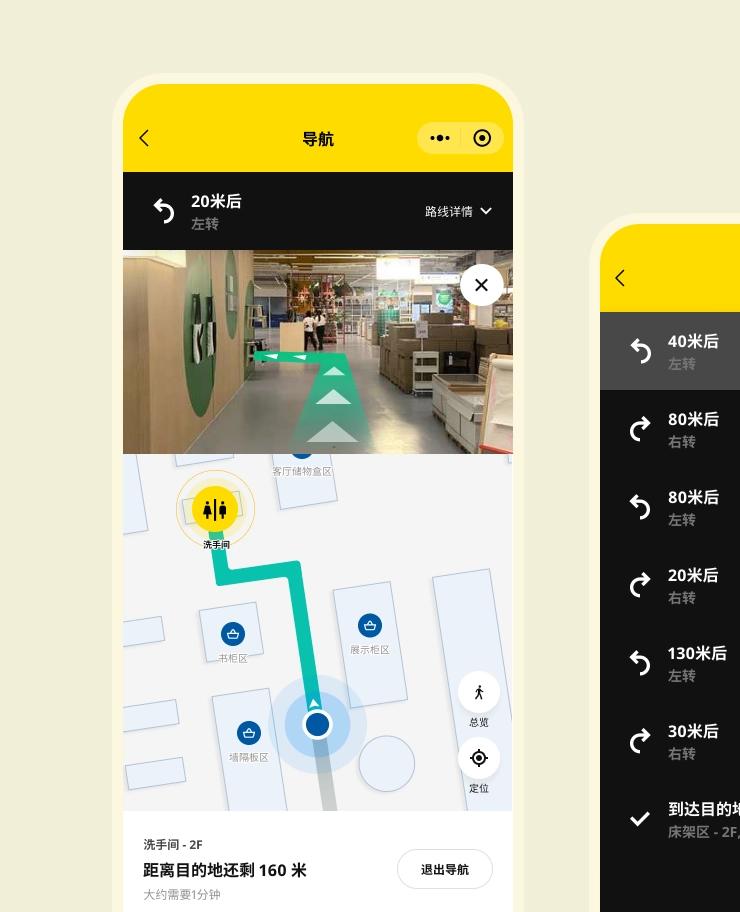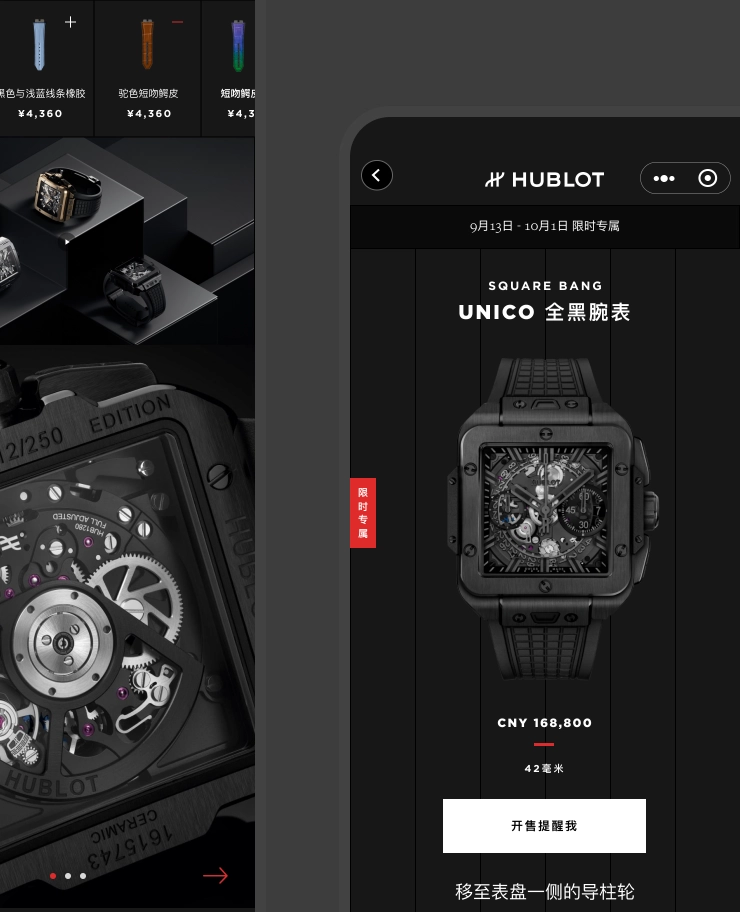How Luxury Brands are Embracing AR and VR to Revolutionize the Online Shopping Experience
October 12th, 2023 · Written by Zippora Lau

Contents
Augmented reality (AR) and virtual reality (VR) are radically transforming the luxury retail landscape, enabling luxury brands to translate their premier in-store customer experiences into captivating new interactive digital realms. As these immersive technologies evolve, luxury brands are at the forefront of pioneering innovative applications that elevate the online shopping journey.
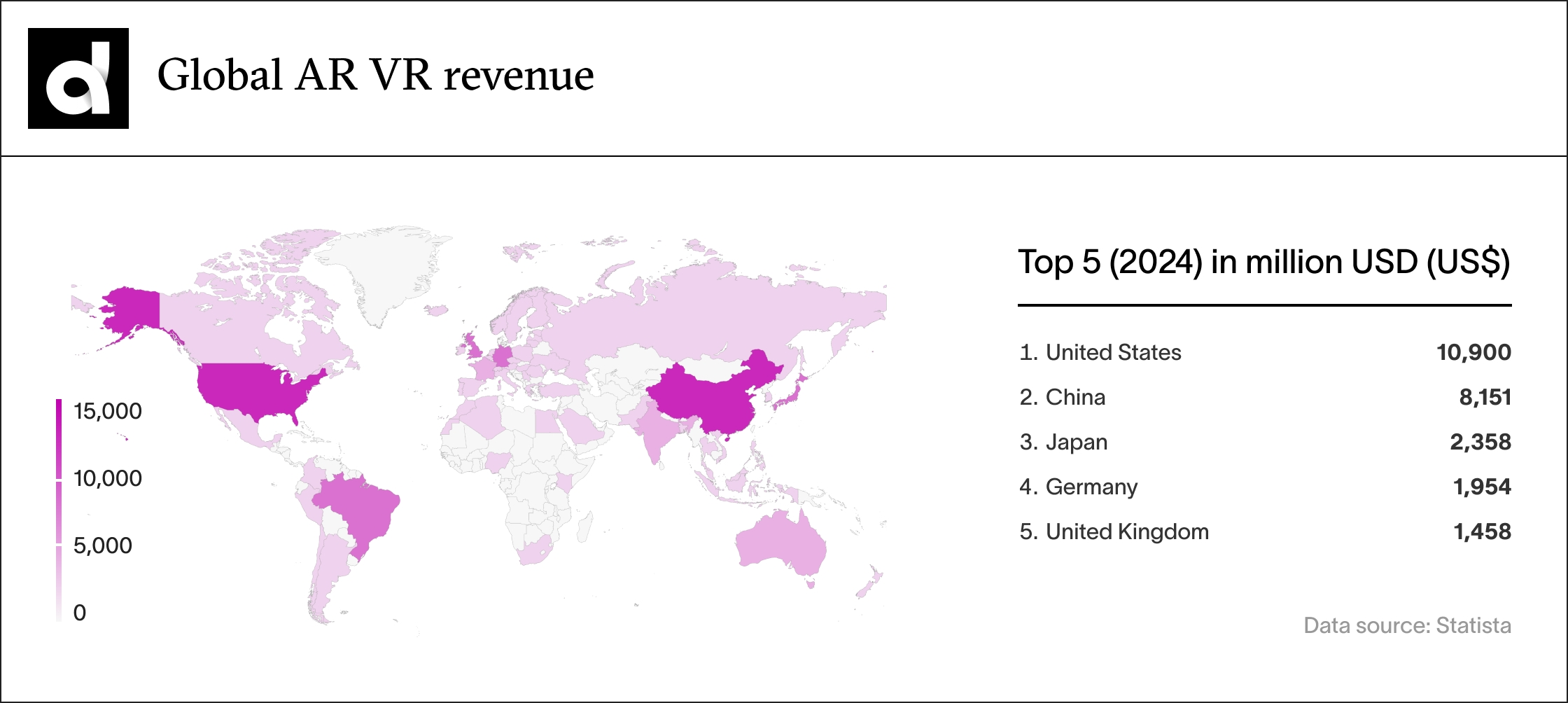
From virtual try-ons that allow customers to visualize products on themselves using AR to fully immersive VR showrooms and digital flagship stores, luxury brands are leveraging cutting-edge tools to create personalized, elevated experiences that cater to the discerning tastes of their clientele. The launch of advanced devices like the Apple Vision Pro has further amplified the potential for luxury brands to redefine the boundaries of ecommerce.
Seeking to engage an increasingly tech-savvy customer base, particularly younger demographics, top-tier labels, and houses are embracing AR and VR to pioneer creative, engaging applications that seamlessly blend the physical and digital worlds. Immersive brand storytelling, personalized virtual styling sessions, and interactive product demonstrations are just a few examples of how luxury brands are transporting the coveted in-store shopping experience into cutting-edge new formats optimized for the digital age.
In this article, we'll explore the creative ways in which leading luxury fashion houses, jewelry brands, automakers, and premium retailers harness AR and VR's power to provide the elevated, personalized experiences their customers crave, both globally and in key markets like China.
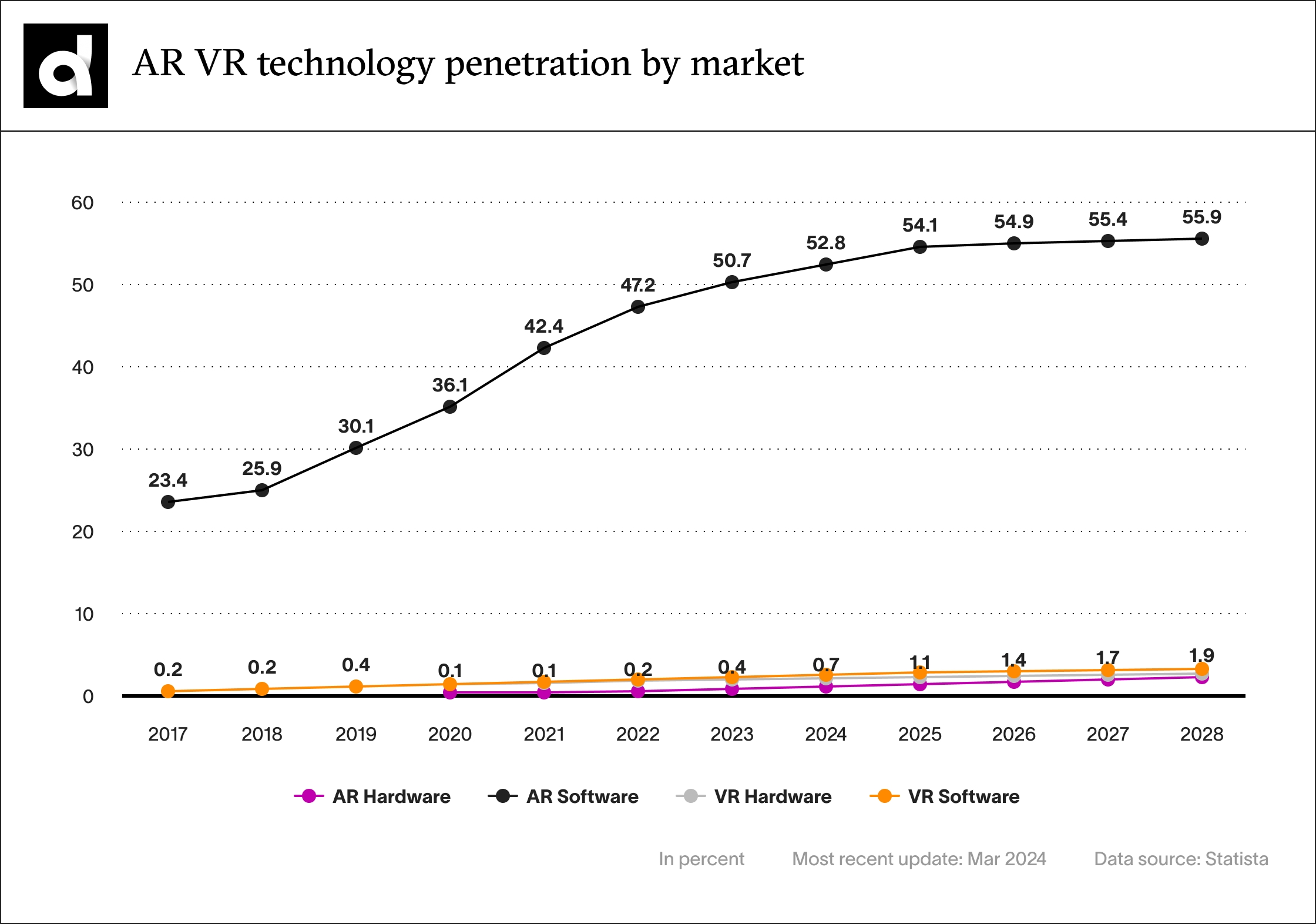
Augmented and Virtual Reality: What’s the Difference
Augmented reality (AR) and virtual reality (VR) are two of the most exciting technologies transforming the retail and ecommerce landscapes. Both offer immersive experiences, but they work quite differently.
As AR and VR technologies continue to evolve, with improved hardware and software capabilities, they are becoming more accessible and enabling luxury brands to push the boundaries of immersive digital experiences.
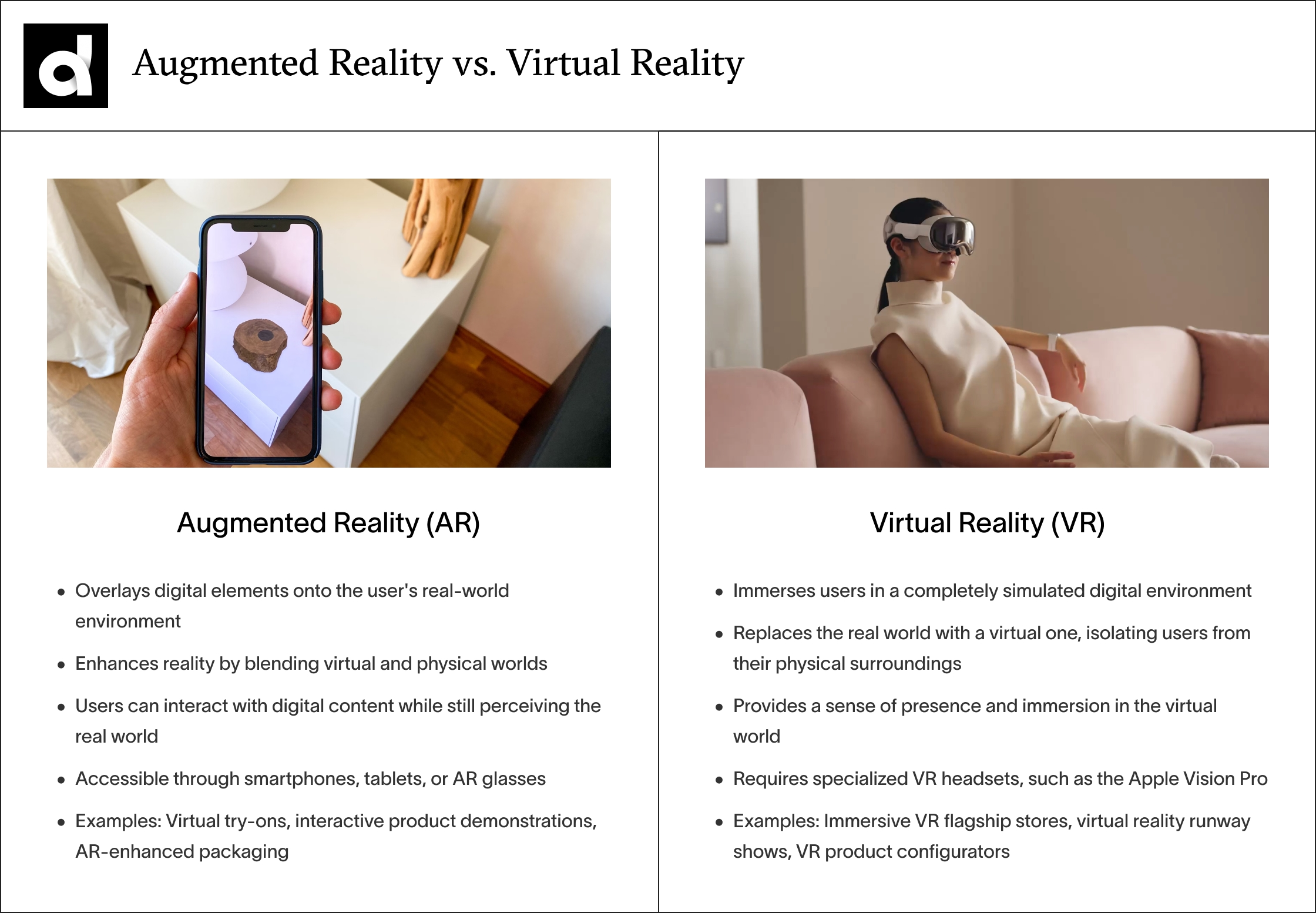
Virtual Reality - Full Immersion in Digital Worlds
Virtual reality aims to completely immerse users in an alternative, computer-generated 3D environment. VR shuts out the real world using headsets that take over your vision and hearing to put you inside a simulated virtual setting.
With VR, your movements directly control what happens when you look around or walk in the virtual world. It convinces your brain you are present in the VR scenario. You are transported to a digital realm where the real world is blocked.
VR has opened up incredible possibilities for imaginative, lifelike simulations with applications across gaming, entertainment, product design, and more. For forward-thinking retailers, VR unlocks new ways to showcase products and engage customers.
Augmented Reality - Digital Overlay on the Real World
Unlike VR, which completely replaces your surroundings, augmented reality brings digital elements into your real-world environment. AR overlays computer-generated imagery, audio, and touch feedback onto your perception of the space around you.
With AR, you view the real environment and the simulated digital augmentations together in a blended interactive experience. The augmented elements look anchored in the real world. AR uses your mobile device camera or smart glasses to determine how the digital overlays integrate with your surroundings.
This allows endless possibilities for information to be layered onto the world around you. Retailers are creatively adopting AR for more immersive, practical, and fun shopping applications.
While VR and AR share immersive capabilities, AR enhances reality while VR replaces it. Together, they offer retailers groundbreaking tools to revolutionize in-store and online customer experiences. The possibilities are limited only by creativity. Brands able to most imaginatively leverage these technologies will have a competitive edge as virtual, augmented, and physical retail collide.
Why AR and VR Are Game Changers for Luxury Ecommerce
Augmented reality and virtual reality are rapidly becoming must-have technologies for forward-thinking luxury fashion houses, jewelry brands, automakers, and premium retailers striving to create immersive digital experiences that cater to the expectations of modern, tech-savvy consumers.
For historically offline luxury brands forced to adapt to the digital-first retail environment accelerated by the pandemic, AR and VR present significant opportunities to replicate the exclusivity, personalized service, and sophistication of their physical flagships in the online realm.
Let's look at the key reasons luxury companies are racing to implement these cutting-edge tools:
Virtual Try-Ons Enhance Product Discovery and Visualization
One of the most compelling applications of AR for luxury brands is enabling virtual try-ons that allow shoppers to visualize products on themselves realistically before making a purchase. This technology has become increasingly sophisticated, with brands like Gucci expanding their AR capabilities to include virtual try-ons for shoes, accessories, and clothing through their app and website.
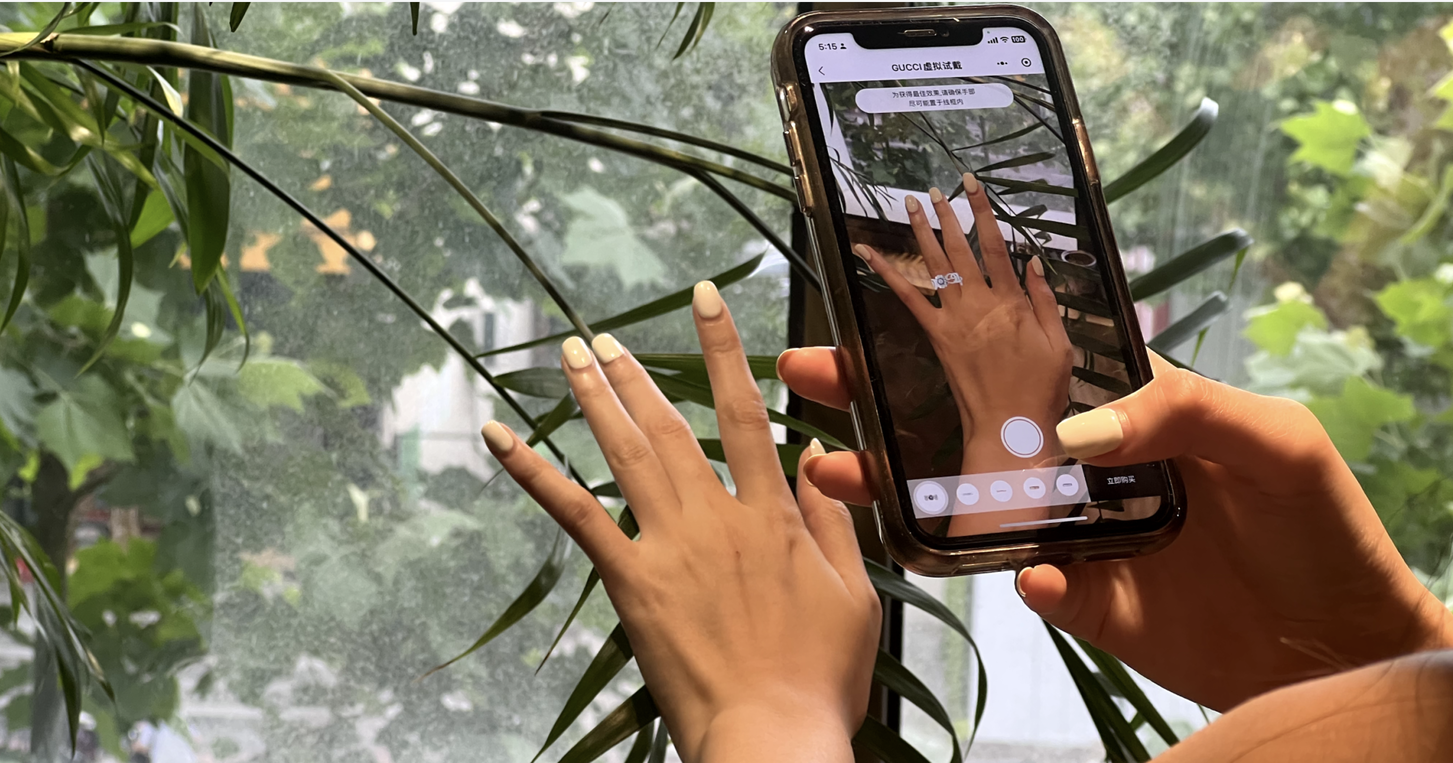
Gucci virtual try on
By merging the convenience of mobile ecommerce with the ability to see how items look and fit, AR try-ons provide customers the confidence to buy, increasing conversion rates while minimizing costly returns. Jewelry brands like Cartier and many luxury makeup brands like Gucci or Dior also leverage AR to let customers virtually try engagement rings and other pieces, helping them visualize different styles and cuts.
Immersive Brand Storytelling and Product Discovery
Virtual reality allows luxury brands to immerse customers in their brand narrative, heritage, and craftsmanship through interactive, digitally rendered experiences. Brands like Louis Vuitton have developed VR experiences that transport customers on a virtual journey, exploring iconic locations and the brand's history.
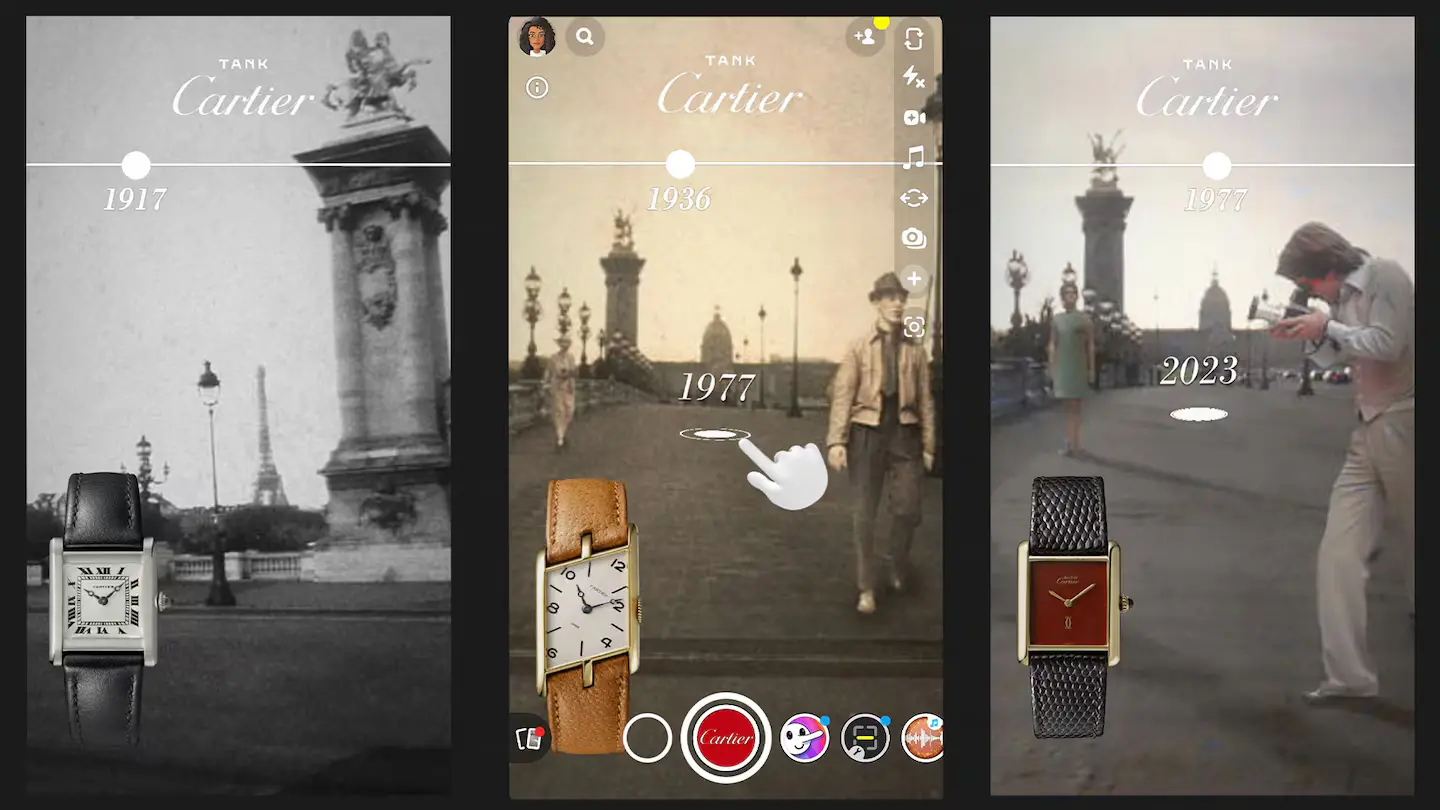
Cartier brand story through the years
Louis Vuitton's 2023 collaboration with artist Yayoi Kusama showcases the power of AR in immersive brand storytelling. Using Snap's Landmarker Lenses, the luxury house virtually adorns iconic landmarks like the Eiffel Tower and Statue of Liberty with Kusama's signature polka dots, creating a captivating narrative that spans both the digital and physical realms. This innovative use of AR technology demonstrates how luxury brands can engage customers through interactive, memorable experiences that deepen brand connection and foster emotional resonance.
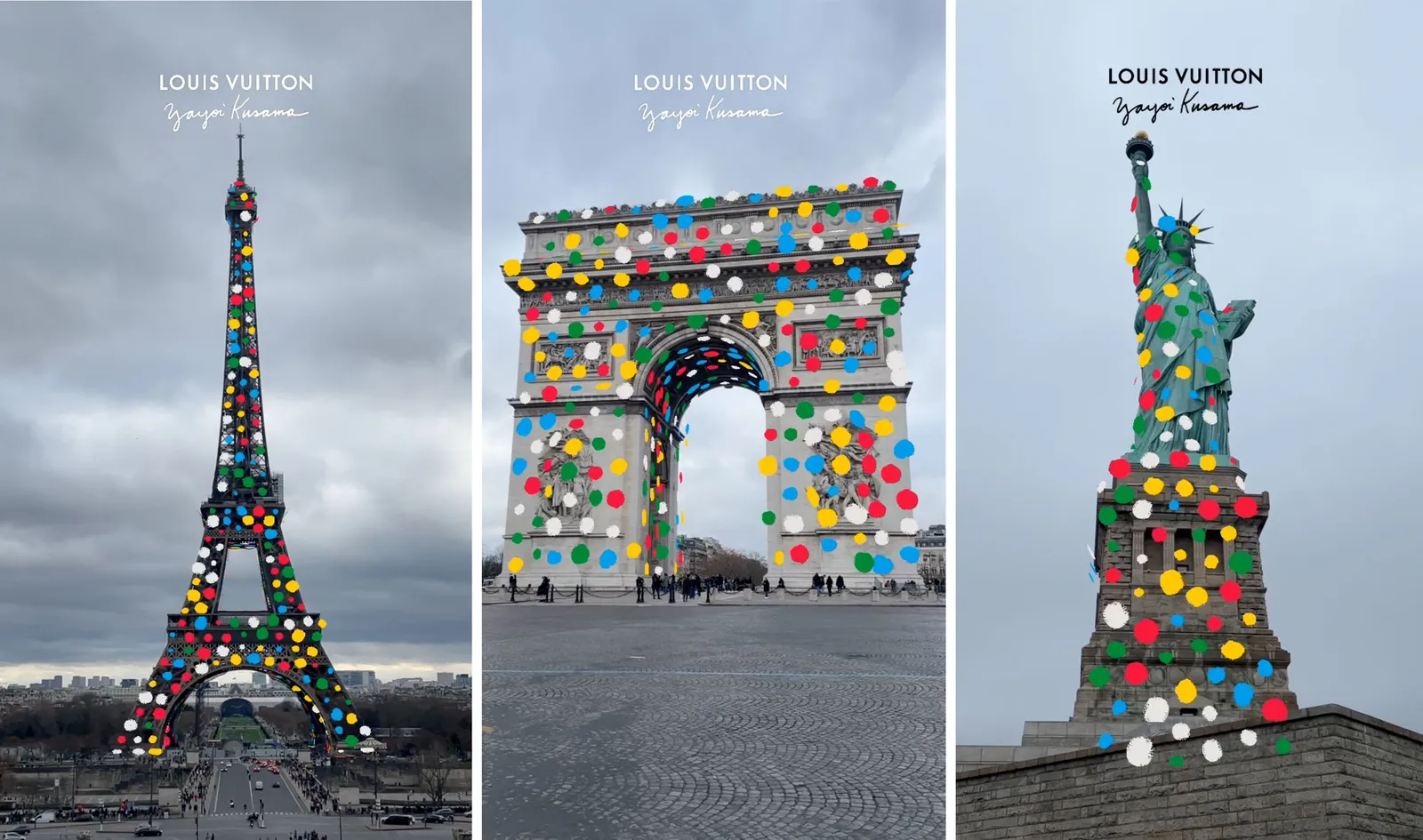
Snap Inc. | Louis Vuitton x Yayoi Kusama
Porsche is pushing the boundaries of product discovery and personalization with its latest mixed-reality Technology Workshops, showcasing the all-electric Macan. Using cutting-edge spatial computing technology and the newly released Meta Quest 3 headsets, Porsche has created an immersive environment where customers and media can explore the vehicle in unprecedented detail.
Wearing the advanced headsets, participants can interact with a virtual representation of the Macan, customizing and examining its features as if the car were physically present. This innovative use of mixed-reality technology allows Porsche to deliver a new level of immersive product demonstration, enabling customers to experience the vehicle in a previously only possible way in physical showrooms.
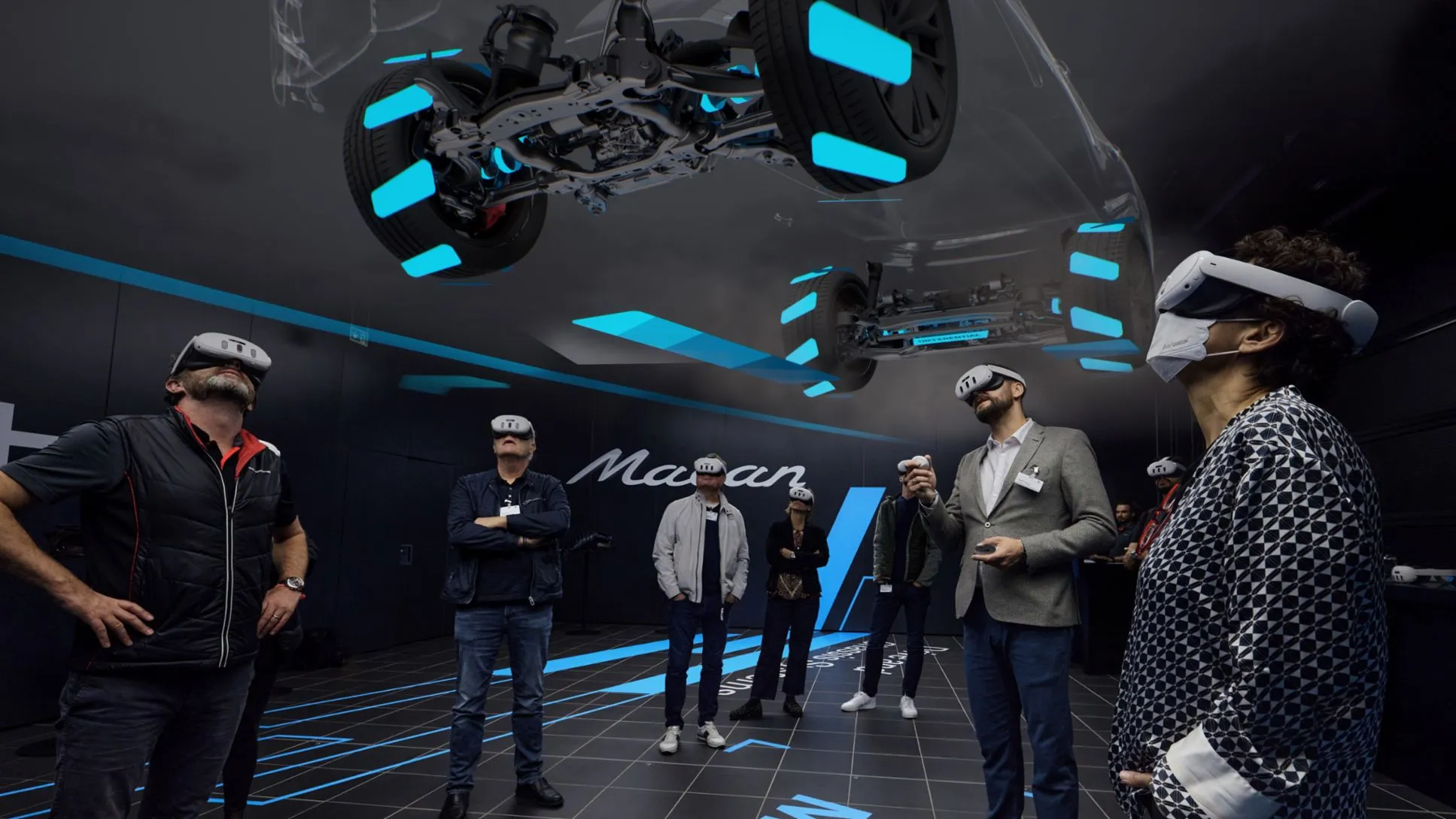
Porsche mixed-reality technology workshop
By leveraging the latest advancements in VR and spatial computing, Porsche sets a new standard for personalized, interactive product discovery in the automotive industry. This approach showcases the brand's commitment to technological innovation and demonstrates how VR can be used to create engaging, memorable experiences that deepen customer understanding and connection with the product.
Personalized Shopping Journeys and Virtual Consultations
Beyond product visualization, AR and VR enable luxury brands to deliver highly personalized, one-on-one shopping experiences akin to in-store service. Automakers can leverage VR configurators to guide customers through bespoke car customizations, while fashion brands can offer virtual styling sessions and personalized wardrobe consultations using advanced VR capabilities.
The introduction of devices like Apple's Vision Pro promises to further revolutionize personalized virtual shopping, with features like eye-tracking and hand gesture controls enabling seamless, intuitive browsing and customization of luxury products in immersive 3D environments.
As luxury consumers increasingly expect digitally driven, innovative shopping experiences, AR and VR are empowering brands to push the boundaries of what's possible online while maintaining the high-touch service and exclusivity that define the luxury experience.
Immerse Customers in Product Details
One of the critical differentiators of luxury products is the meticulous craftsmanship and quality details infused into each item by skilled artisans. Augmented and virtual reality allow ecommerce customers to inspect and interact with products digitally in a more profound, more meaningful way.
For example, an AR app can let a watch enthusiast study a timepiece up close from all angles, seeing the intricate inner workings move as if they are holding it in their hand at the counter. Details invisible in static product photos come to life.
Fashion brands can provide 360-degree virtual reality visualizers, allowing online buyers to open zippers, inspect stitching, and view inside compartments from multiple vantage points.
Luxury automakers utilize VR test drives so customers can open doors, pop the hood, adjust seats, and control infotainment displays to appreciate thoughtful touches and material selections.
This unrestricted digital access, paired with the sensory realism of AR and VR, elicits an emotional thrill in luxury shoppers, similar to unboxing an item in the flagship boutique.
For historically product-focused luxury brands, AR and VR are the keys to translating the tangible prestige of the in-person shopping experience to mobile and desktop. The more digital tools can immerse ecommerce customers in product details, the stronger the emotional and financial investment.
AR and VR Position Luxury Brands as Innovation Leaders
For luxury brand shoppers, being ahead of the curve and associated with cutting-edge innovation is intrinsically tied to the appeal of high-end goods. Implementing modern technologies like augmented and virtual reality allows premium fashion houses, automakers, and retailers to be perceived as trailblazing digital innovators.
By merging online shopping with bleeding-edge immersive experiences provided by AR/VR, luxury brands cater to customers who seek exclusivity as a symbol of progressive social status. Virtual features like digital flagship stores, holographic product displays, and immersive runway shows attract those who value individuality and tech-savvy innovation when making luxury purchases.
Many high-fashion brands leverage VR technology to create immersive virtual runway experiences, live-streaming fashion shows in VR to make viewers feel like they are sitting in the front row and stand out from traditional legacy brands still operating primarily offline.
The Apple Vision Pro: A Game-Changer for Luxury Ecommerce
The introduction of Apple's Vision Pro mixed reality headset in 2023 marked a significant milestone for luxury brands in immersive digital experiences. As an all-in-one device seamlessly blending virtual and augmented reality, the Vision Pro opened new possibilities for creating highly interactive and engaging ecommerce environments.
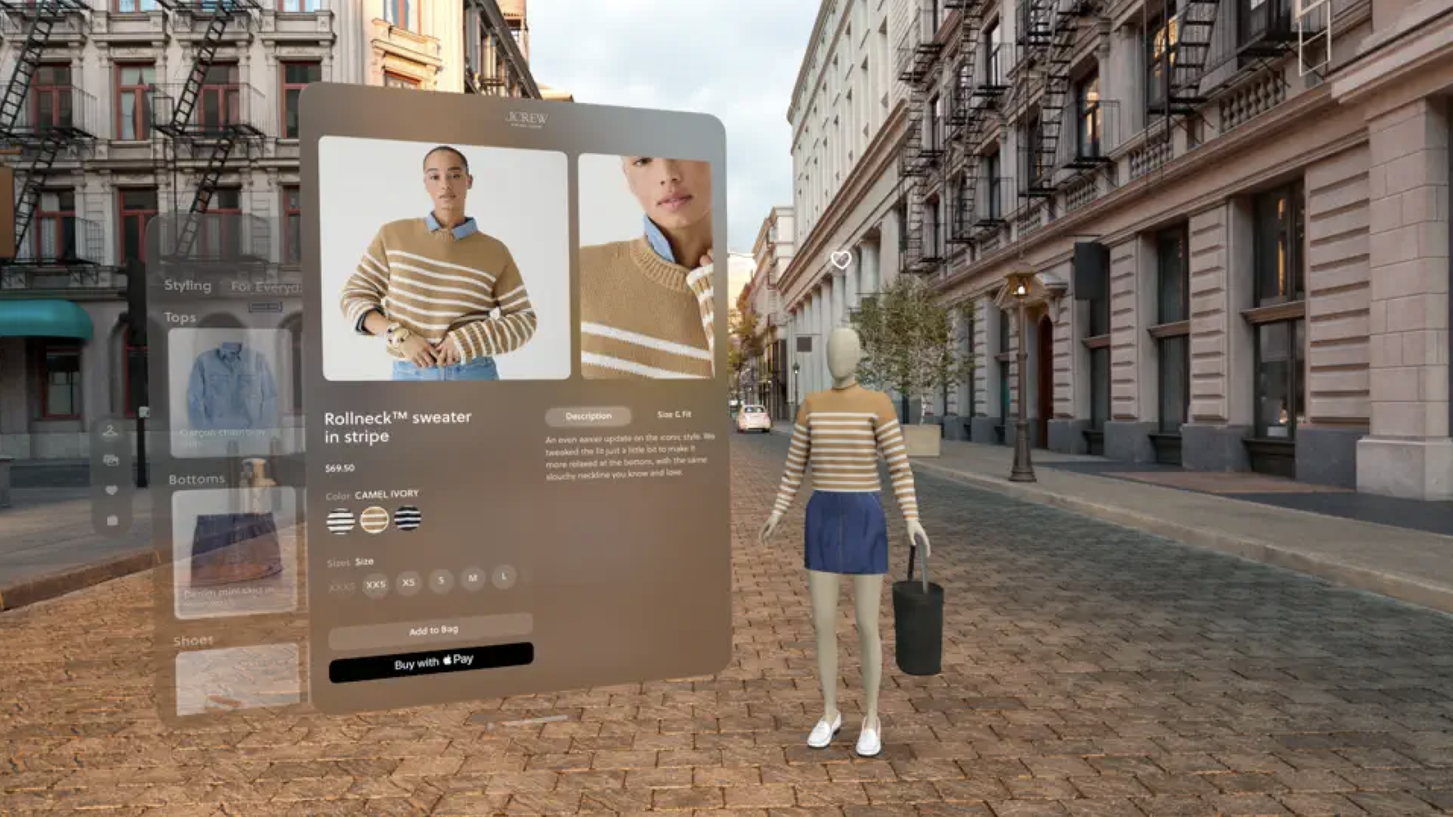
J.Crew for Apple Vision Pro virtual store
Several luxury brands and retailers, including MyTheresa, J.Crew, E.l.f Cosmetics, and Alo Yoga, quickly embraced the Vision Pro, launching immersive fashion experiences on the device soon after its release. These early adopters are paving the way for more sophisticated applications.
.webp)
MYTHERESA Apple Vision Pro storefront
The Vision Pro's advanced capabilities, including real-time product visualization, data-driven insights, and seamless social shopping experiences, position luxury brands at the forefront of VR ecommerce innovation. As mass adoption of the device increases, brands experimenting with these immersive formats will gain a competitive edge, shaping the future of luxury retail in the digital realm.
While risky, being an early adopter of emerging tech trends like the Vision Pro provides an essential competitive advantage in the luxury space. AR and VR offer brands a conduit to stay ahead of the curve consistently, which is crucial in the rapidly evolving digital retail landscape catering to increasingly tech-savvy and experience-driven luxury consumers.
The core luxury customer craves constant modernization fused with heritage. By boldly embracing boundary-pushing technologies like AR and VR, brands future-proof their elite status and lead the next generation of retail experiences, both in-store and online.
Advanced Customer Data to Enhance Personalization
A powerful benefit of augmented reality (AR) and virtual reality (VR) experiences is the troves of behavioral data these tools collect when consumers interact with digital content. Luxury brands leverage this data to provide personalized recommendations and tailored shopping journeys.
For example, AR virtual try-on tools allow customers to view products modeled on themselves and capture sizing information, style preferences, and items tried. VR showrooms log data on options configured, areas explored, and time spent customizing.
Every click, swipe, and selection in these immersive digital environments creates data points to build rich customer profiles. With user permission, this intel can be tied to CRM data for a 360-degree view of each luxury buyer.
These insights inform everything from customized product recommendations to individualized email/push messaging. If a customer spends time customizing a luxury watch in VR, the brand can follow up with similar timepiece options tailored to their specifications.
China Embraces AR and VR Experiential Luxury Commerce
As one of the biggest luxury markets globally, China has been at the forefront of embracing AR and VR technologies to enhance ecommerce experiences, driven by a vast, tech-savvy consumer base.
Chinese luxury shoppers expect constant digital innovation and highly interactive, engaging shopping journeys. As such, premium brands have been catering to local preferences by delivering immersive digital commerce environments powered by AR and VR.
Embracing AR for Interactive, Gamified Experiences
Young, fashion-forward Chinese luxury shoppers value novel digital marketing campaigns and gamified, interactive content. To cater to these preferences, brands have been leveraging AR in creative ways:
WeChat gamification - Brands like Dior and Givenchy have created mini-games to generate a buzz on WeChat. Participants could win prizes.
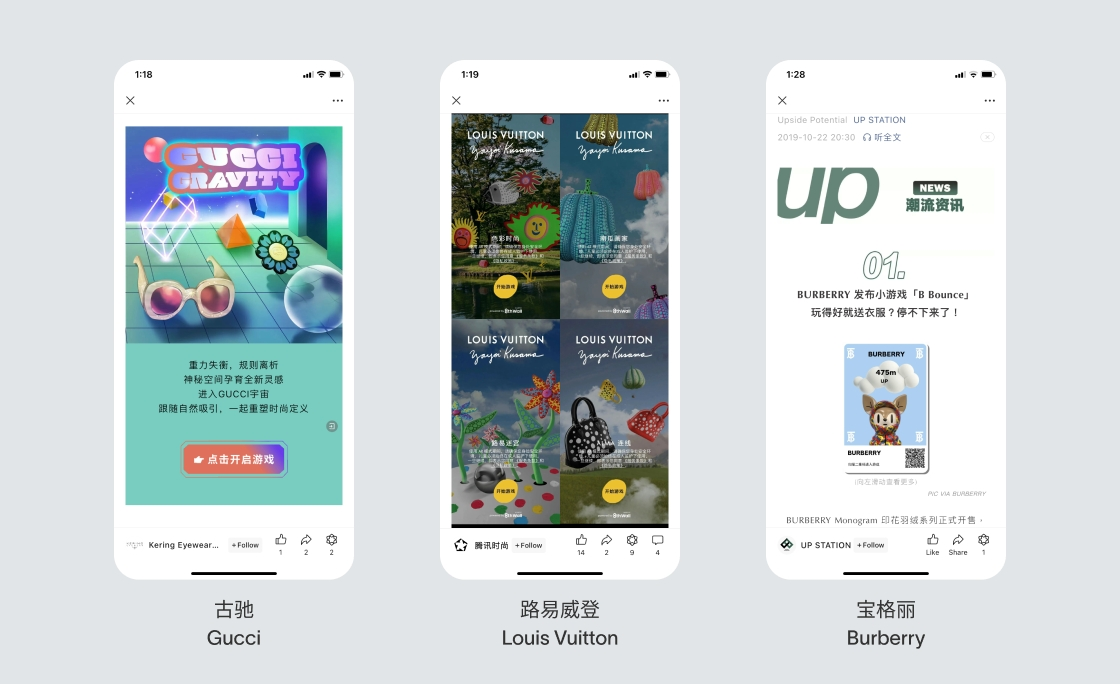
AR Art Filters: Many luxury brands release fun AR filters overlaying brand elements onto photos shared on WeChat and Douyin (TikTok), encouraging user engagement and social sharing.
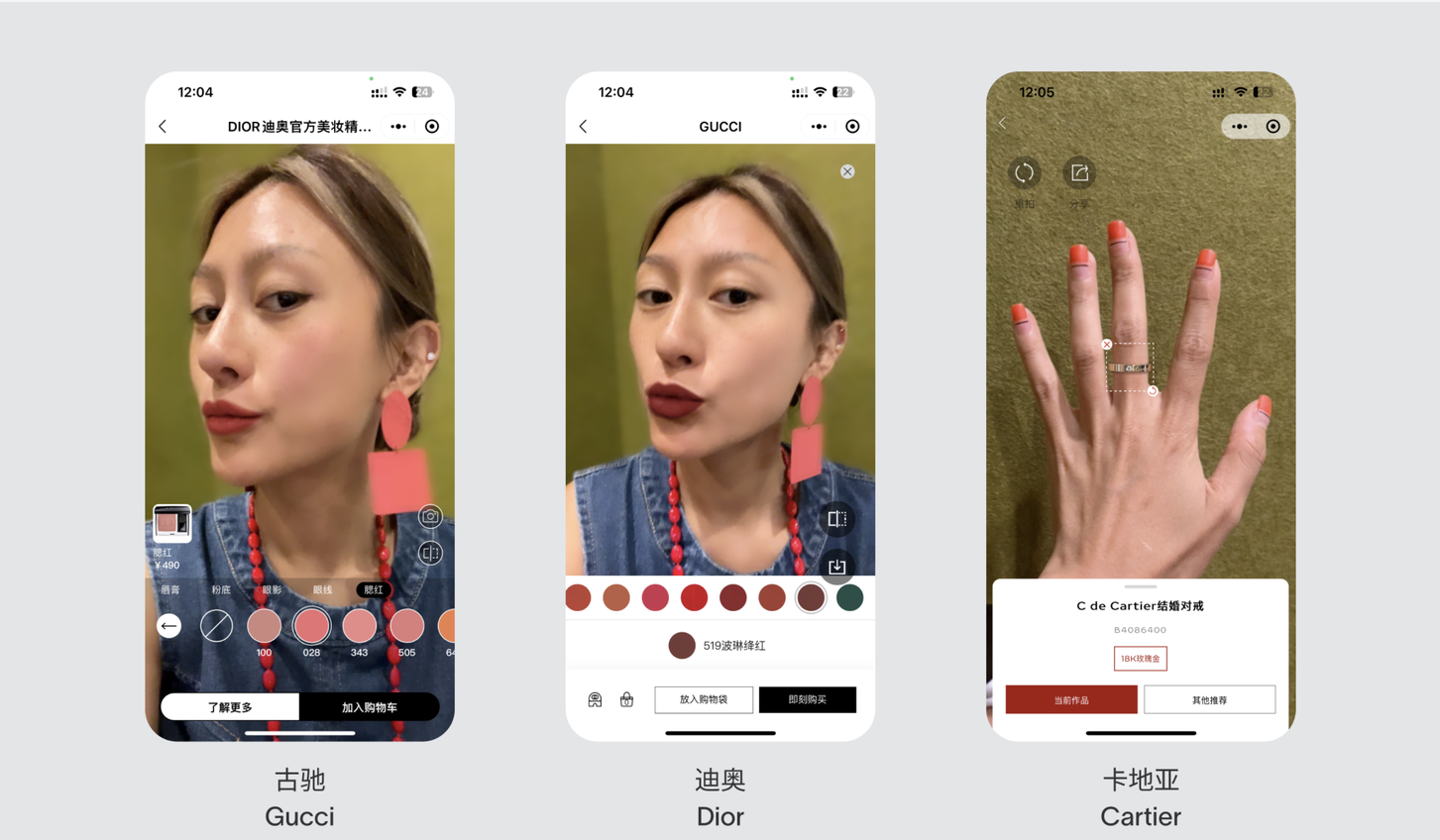
AR-Enhanced Shopping Festivals: During major shopping events like Singles' Day, platforms like Tmall incorporate AR experiences, enabling online buyers to play brand games and earn rewards through AR interactions.
By blending entertainment and shopping, these AR activations attract younger Chinese consumers to luxury brands in the digital spaces where they spend significant time. Interactive AR ads have seen triple the engagement compared to static ones in China.
Immersive VR Experiences for Next-Level Brand Storytelling
While AR has been more widely adopted in China's luxury market, Virtual Reality is set to take the consumer experience to new heights. As VR technology becomes more accessible and affordable, Chinese consumers are increasingly eager to explore immersive, experiential brand interactions.
Chinese luxury shoppers value VIP treatment and personalized service, even in online environments. VR technology provides a higher-touch, omnichannel customization that mimics boutique interactions:
Virtual Flagships on Tmall Luxury Pavilion: Brands like Tiffany have created VR stores on Tmall, allowing buyers to digitally interact with products and feel immersed before making high-value purchases.
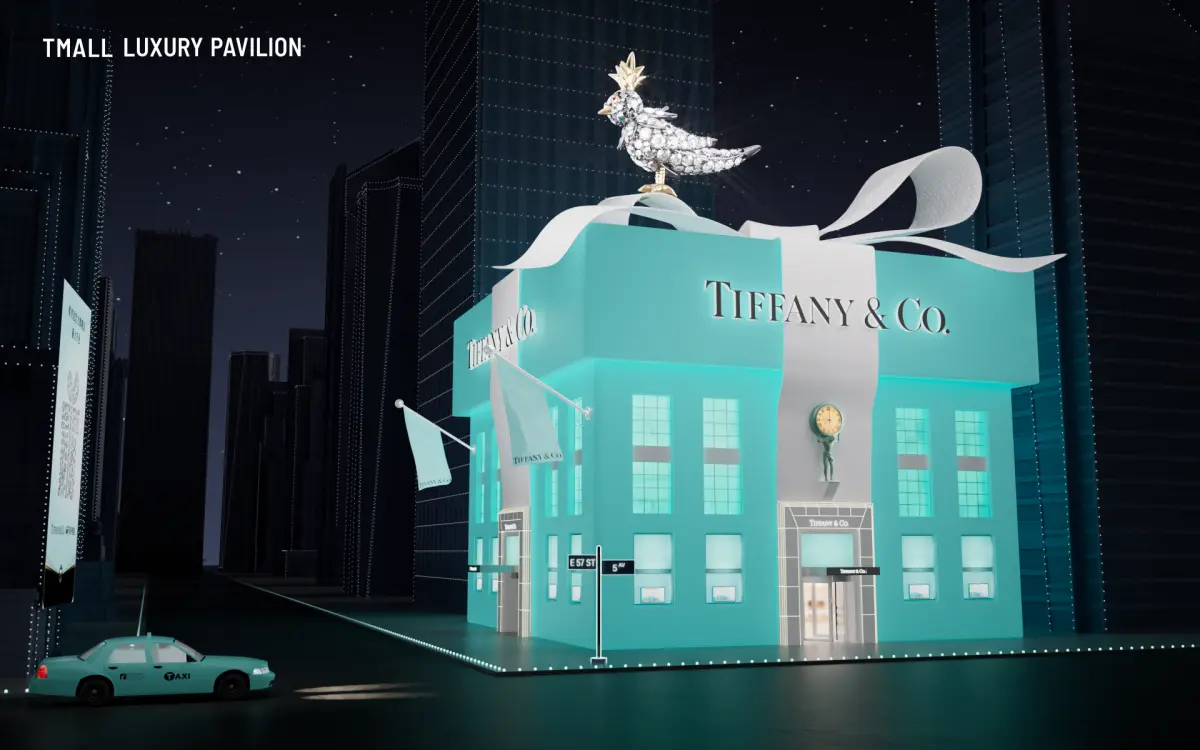
Tiffany&Co Tmall luxury pavilion storefront
In-Store VR Experiences: Luxury malls and flagship stores combine VR product showcase and gamification elements. Chinese consumers expect these immersive digital elements to be integrated into physical retail environments.
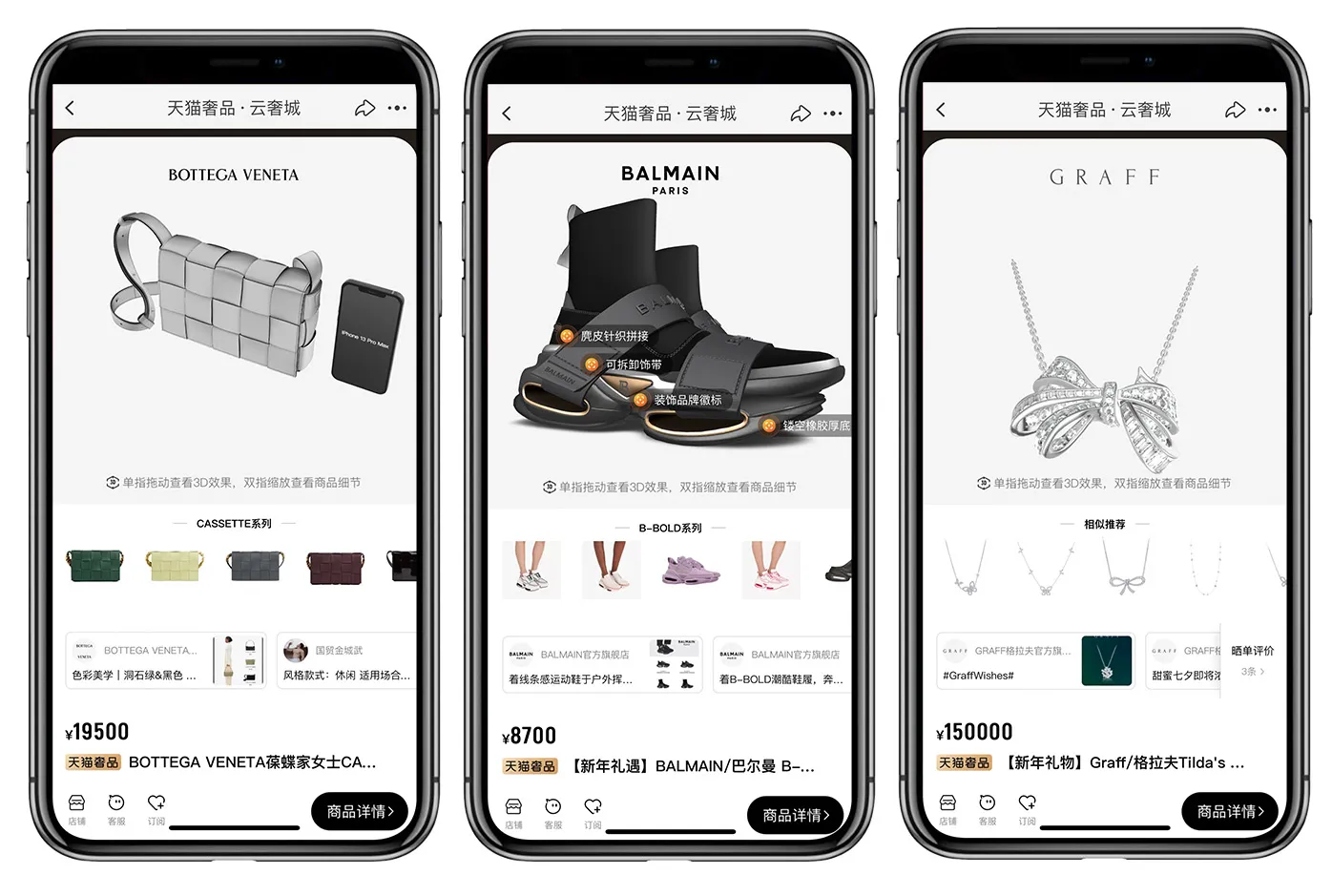
With China leading global VR adoption, luxury brands that can effectively leverage the technology to satisfy Chinese consumers' appetite for digital immersion gain a competitive edge in this crucial market.
The Apple Vision Pro and the Future of Luxury Ecommerce in China
The highly anticipated introduction of Apple's Vision Pro mixed reality headset in China later this year is poised to accelerate the transformation of the country's luxury e-commerce landscape. With Chinese consumers already demonstrating a strong appetite for AR and VR shopping experiences, Vision Pro is expected to drive increased investment from luxury brands targeting this market.
Consumer Expectations and Brand Opportunities:
1. Virtual Flagship Stores and Product Demonstrations: Luxury brands will likely invest in creating virtual flagship stores, AR product demonstrations, and personalized styling sessions on Vision Pro to leverage its advanced capabilities.
2. Social and Shared Shopping Experiences: Capitalizing on the popularity of social commerce in China, brands may develop shared VR shopping experiences where customers can invite friends, get real-time feedback, and make purchases together.
3. Immersive Brand Collaborations and Exclusive Product Launches: Major Chinese ecommerce platforms like Tmall and JD.com are expected to partner with luxury brands to create exclusive VR experiences, such as virtual pop-up stores, limited-edition product launches, and immersive brand collaborations.
4. Gamification and Interactive Storytelling: To engage tech-savvy Chinese shoppers, luxury brands may incorporate gamification elements, virtual treasure hunts, branded mini-games, and immersive storytelling into their VR ecommerce experiences.
5. Personalization Through Advanced Tracking: The Vision Pro's advanced tracking capabilities will provide luxury brands with valuable data on Chinese consumers' preferences and behaviors in VR environments, enabling highly personalized product recommendations, marketing campaigns, and customer experiences.
Blurring the Lines Between Online and Offline:
As more Chinese consumers adopt the Apple Vision Pro, the lines between online and offline luxury shopping experiences are expected to blur further. VR experiences could be leveraged to drive traffic to physical stores, while in-store experiences may incorporate AR and VR elements, creating a seamless omnichannel journey for customers.
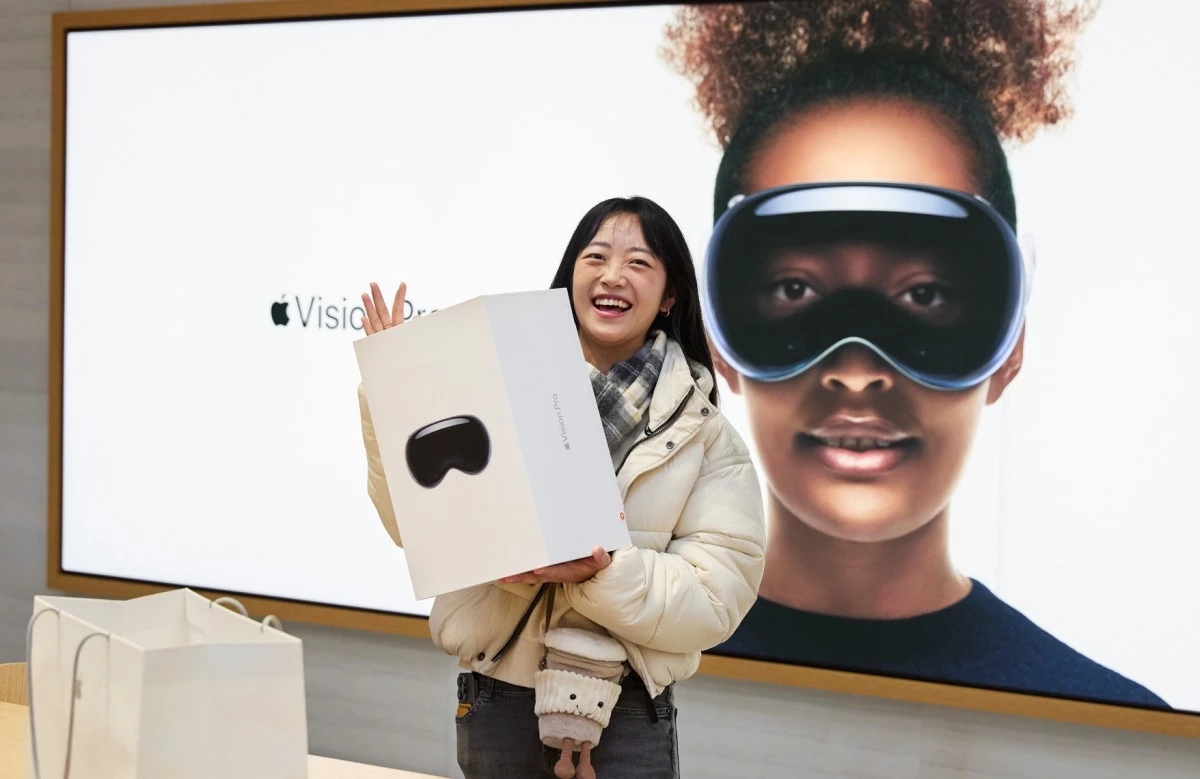
The introduction of the Apple Vision Pro in China is set to usher in the country's new era of interactive, personalized, and socially-driven luxury ecommerce. As brands compete to create the most engaging and immersive VR shopping experiences, those that can effectively cater to the demands of tech-savvy Chinese luxury shoppers will gain a significant competitive advantage in this crucial market.
When to Use AR & VR for Maximum Impact
As AR and VR technologies continue to evolve and become more accessible, luxury brands should strategically leverage these tools to create immersive experiences that captivate their target audience. Here are some key opportunities where AR and VR can have the most significant impact:
Product Launches and Limited-Edition Collections
-
Use AR product visualization to generate buzz and allow customers to explore new items in detail before they become available for purchase.
-
Create VR experiences that transport customers to exclusive virtual events or behind-the-scenes looks at the design and creation process.
Seasonal Campaigns and Holiday Shopping
-
Develop AR gift guides and virtual try-on experiences to help customers find the perfect presents during peak shopping periods like Christmas, Valentine's Day, and Singles' Day.
-
Offer VR boutique experiences that capture the magic of holiday shopping, complete with personalized recommendations and exclusive offers.
Fashion Weeks and Runway Shows
-
Provide VR front-row seats to fashion shows, allowing global audiences to experience the latest collections up close and in real time.
-
Use AR to enable customers to try on looks from the runway, increasing engagement and driving sales.
Brand Heritage and Storytelling
-
Leverage VR to create immersive experiences that showcase the brand's history, craftsmanship, and iconic products, deepening customer connections and loyalty.
-
Incorporate AR elements into flagship stores and pop-up events to blend physical and digital storytelling.
Influencer Collaboration
-
Develop AR or VR content with a top influencer who can help promote and share with their following and generate more word-of-mouth buzz.
-
Add AR or VR elements into live streams on platforms like Douyin to create interactive and memorable digital shopping experiences.
Personalization and Virtual Consultations
-
Use AR and VR to provide one-on-one virtual styling sessions, product customization, and tailored recommendations based on customer preferences and behavior data.
-
Integrate AI-powered chatbots and virtual assistants to guide customers through immersive shopping experiences and provide real-time support.
Social and Interactive Shopping
-
Create AR filters and branded mini-games that encourage social sharing and user-generated content, particularly on platforms popular among younger audiences like WeChat and Douyin.
-
Develop VR shopping experiences that allow customers to invite friends, interact with products, and share their favorite items and looks.
By strategically deploying AR and VR technologies during these key moments and experiences, luxury brands can create engaging, memorable, personalized shopping journeys that resonate with their target audience. As the capabilities of AR and VR continue to expand, brands that effectively leverage these tools to complement their overall marketing and ecommerce strategies will be well-positioned to capture the attention and loyalty of today's tech-savvy luxury consumers.
Future of AR & VR for Luxury Brands
As AR and VR technologies continue to advance rapidly, the future of luxury ecommerce looks increasingly immersive and interactive. With the introduction of cutting-edge devices like the Apple Vision Pro and the growing adoption of these technologies among consumers, particularly in China, luxury brands are poised to embrace a new era of digital innovation.
Looking ahead, we can expect to see more sophisticated applications of AR and VR in the luxury space, such as:
-
Hyper-realistic virtual try-on experiences incorporating advanced body tracking and real-time product rendering allow customers to visualize products on themselves with unprecedented accuracy.
-
Immersive VR flagship stores that replicate the grandeur and personalized service of physical boutiques, complete with AI-powered virtual assistants and real-time interactions with brand representatives.
-
AR-enhanced packaging and unboxing experiences that bring products to life through interactive storytelling and exclusive digital content.
-
VR-powered personalization and customization enabling customers to co-create bespoke products and see their unique designs come to life in immersive 3D environments.
-
Seamless integration of AR and VR experiences across online and offline touchpoints, creating cohesive omnichannel journeys that blend the best of both worlds.
In China, the rapid adoption of AR and VR technologies, coupled with the tech-savvy nature of Chinese luxury consumers, presents a particularly exciting opportunity for brands to innovate and differentiate themselves. As the country embraces the Apple Vision Pro and other advanced devices, we can expect to see a surge in immersive ecommerce experiences tailored to the preferences and behaviors of Chinese shoppers.
Luxury brands that successfully leverage AR and VR to create emotionally resonant, socially connected, and highly personalized shopping experiences will be well-positioned to capture the hearts and wallets of Chinese consumers. By partnering with local ecommerce giants like Tmall and JD.com and leading digital agencies with expertise in the Chinese market, brands can accelerate their adoption of these technologies and stay ahead of the curve.
As virtual, augmented, and physical retail continue to converge, luxury brands that prioritize digital innovation and customer-centricity will emerge as the winners in this new era of experiential commerce. By boldly embracing the possibilities of AR and VR, they will redefine what it means to shop for luxury in the digital age, creating immersive, memorable, and emotionally engaging experiences that set them apart from the competition.
The future of luxury ecommerce is undeniably intertwined with the rapid advancements in AR and VR technologies. As consumer expectations evolve and the demand for immersive, personalized experiences grows, particularly in markets like China, luxury brands must embrace digital innovation to remain competitive and relevant.
Navigating this new landscape requires a deep understanding of user needs, technological capabilities, and market nuances. This is where partnering with a skilled and experienced digital product development agency can make all the difference. Agencies like Digital Creative Asia specialize in helping ambitious startups and leading brands create cutting-edge digital experiences that resonate with their target audiences.
With a team of strategists, creatives, and tech experts passionate about delivering best-in-class solutions, we are well-positioned to support luxury brands adopting AR and VR technologies. Our expertise spans the full spectrum of digital innovation, from crafting immersive VR flagship stores to developing engaging AR product visualizations.
The future of luxury ecommerce is here - are you ready to embrace it? Get in touch now, and let's start bringing your brand's vision to life.
Have a project in mind?
Join our newsletter!
Get valuable insights on the latest digital trends, strategies, and developments in China and globally delivered straight to your inbox.
